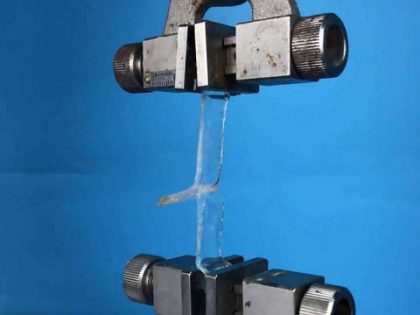 According to a new scientific report at “phys.org” website; A painless adhesive: Adhesives for biomedical applications can be detached with light and so pulling off a Band-Aid may soon get a lot less painful for users.
According to a new scientific report at “phys.org” website; A painless adhesive: Adhesives for biomedical applications can be detached with light and so pulling off a Band-Aid may soon get a lot less painful for users.
Researchers from the Harvard John A. Paulson School of Engineering and Applied Sciences (SEAS) and Xi’an Jiaotong University in China have developed a new type of adhesive that can strongly adhere wet materials—such as “hydrogel” and living tissue—and be easily detached with a specific frequency of light.
The adhesives could be used to attach and painlessly detach wound dressings, transdermal drug delivery devices, and wearable robotics.
The paper is published in Advanced Materials.
“Strong adhesion usually requires covalent bonds, physical interactions, or a combination of both,” said Yang Gao, first author of the paper and researcher at Xi’an Jiaotong University. “Adhesion through “covalent bonds” is hard to remove and adhesion through physical interactions usually requires solvents, which can be time-consuming and environmentally harmful. Our method of using light to trigger detachment is non-invasive and painless.”
The adhesive uses an aqueous solution of “polymer chains” spread between two, non-sticky materials—like jam between two slices of bread. On their own, the two materials adhere poorly together but the polymer chains act as a molecular suture, stitching the two materials together by forming a network with the two preexisting polymer networks. This process is known as topological entanglement.
When exposed to ultra-violet light, the network of stitches dissolves, separating the two materials.
The researchers, led by Zhigang Suo, the Allen E. and Marilyn M. Puckett Professor of Mechanics and Materials at SEAS, tested adhesion and detachment on a range of materials, sticking together hydrogels; hydrogels and organic tissue; elastomers; hydrogels and elastomers; and hydrogels and inorganic solids.
“Our strategy works across a range of materials and may enable broad applications,” said Kangling Wu, co-lead author and researcher at Xi’an Jiaotong University in China.
While the researchers focused on using UV light to trigger detachment, their work suggests the possibility that the stitching polymer could detach with near-infrared “light”, a feature which could be applied to a range of new medical procedures.
“In nature, wet materials don’t like to adhere together,” said Suo. “We have discovered a general approach to overcome this challenge. Our molecular sutures can strongly adhere wet “materials” together. Furthermore, the strong “adhesion” can be made permanent, transient, or detachable on demand, in response to a cue. So, as we see it, nature is full of loopholes, waiting to be stitched.”
For more information about this topic you can read “Phys”
These two hydrogels, adhered with an aqueous solution of polymer chains, come apart easily In the presence of UV light. Credit:
************************
Why Should Be “A Paid-Subscriber” and “Advertiser”
Keeping an independent media in countries that impose limitations on self supporting media, will help to support the humankind’s freedom. If you believe it, please act to be a PRO-MEMBER by clicking “HERE“, or:
Please send your PR’s directly to the email address of the Chief-Editor in order to be published at once in the world via ” http://pimi.ir ” The address is: aasaatnia@live.com.













